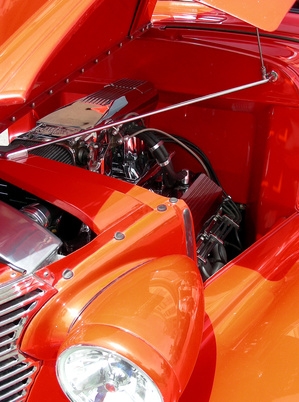
The 350-cubic inch Chevy engine first appeared in 1967 in the Chevrolet Camaro. It was made available in other cars and trucks in 1969. The 350 Chevy is probably the most popular and widely used performance engine of all time, and there is a large selection of aftermarket parts available. The valve train on the 350 consists of a camshaft with hydraulic lifters that transfer cam lift to the valves via tubular push rods and rocker arms. Hydraulic lifters eliminate the need for regular valve lash adjustments. If the rocker arms have been loosened, the initial valve lash will have to be set.
Remove the valve covers with a ratchet and socket.
Detach the spark plug wires from the spark plugs then remove the spark plugs.
Turn the engine over until the timing groove on the harmonic balancer lines up with "0" on the timing marker. You can do this with a socket on the crankshaft pulley or by pulling on the fan belt. Move the engine in a clockwise direction. Look at the valves on the number one cylinder. They should both be closed when the groove is lined up. If one valve is open, rotate the engine one complete turn until the groove is lined up again. Both valves should now be closed.
Adjust the following valves: the exhaust valves on cylinders 1, 3, 4 and 8, then the intake valves on cylinders 1, 2, 5 and 7. Adjust them by loosening the pivot nut in the center of the rocker arm until you can rotate the push rod between your fingers. Continue to rotate the push rod while you tighten down the nut. As soon as pressure stops the push rod from turning, tighten the nut an additional complete turn. Do this for each of the valves listed above.
Rotate the engine clockwise one complete turn and line up the groove with the timing marker as in Step 3. Both valves on the number six cylinder should now be closed. Adjust the following valves: The exhaust valves on cylinders 2, 5, 6 and 7, then the intake valves on cylinders 3, 4, 6 and 8.
Replace the spark plugs. Check the valve cover gasket for damage and replace if necessary, by removing the old gasket and cleaning any remaining gasket material from the valve covers and cylinder heads. Some 350s have rubber gaskets that can be reused. Cork gaskets usually need to be replaced. Apply gasket sealer to one side of each gasket and press it onto the valve covers. Apply sealer to the other side of the gasket and seat the valve covers onto the cylinder heads. Install and tighten the bolts. Replace the spark plug wires.